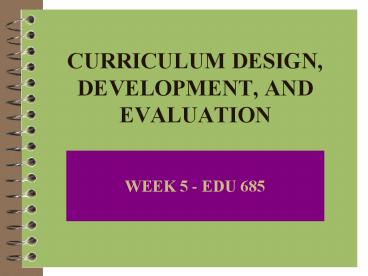CURRICULUM DESIGN, DEVELOPMENT, AND EVALUATION - PowerPoint PPT Presentation
1 / 36
Title:
CURRICULUM DESIGN, DEVELOPMENT, AND EVALUATION
Description:
Method & organization - What instructional strategies, resources, and activities ... made for valid educational reasons, not for specious or noneducational reasons. ... – PowerPoint PPT presentation
Number of Views:41291
Avg rating:5.0/5.0
Title: CURRICULUM DESIGN, DEVELOPMENT, AND EVALUATION
1
CURRICULUM DESIGN, DEVELOPMENT, AND EVALUATION
- WEEK 5 - EDU 685
2
COMPONENTS OF DESIGN
- Objectives - What is to be done?
- Subject matter - What subject matter is to be
included? - Method organization - What instructional
strategies, resources, and activities will be
used? - Evaluation - What methods and instruments will be
used to assess results?
3
SOURCES OF DESIGN
- Science
- Society
- Eternal Divine
- Knowledge
- The Learner
4
KEY DIMENSIONS
- Scope
- Sequence
- Continuity
- Integration
- Articulation
- Balance
5
SUBJECT-CENTERED DESIGNS
- Subject
- Discipline
- Broad fields
- Correlation
- Process
6
LEARNER-CENTERED DESIGNS
- Child-centered
- Experience-centered
7
PROBLEM-CENTERED DESIGNS
- Life-situation
- Social problems
8
CURRICULUM DEVELOPMENT
- APPROACHES
9
TECHNICAL-SCIENTIFIC APPROACH
- Curriculum development is a plan or blueprint
- structuring the learning environment
- coordinating personnel, materials, and equipment
- Curriculum development has a high degree of
objectivity, universality, and logic - Reality can be defined and represented in
symbolic form - Believers prize optimum growth, maximum
efficiency and effectiveness of the system - The world is viewed as a machine that can be
observed and manipulated
10
THE TYLER MODEL
- Purposes of school
- Educational experiences related to purposes
- Organization of these experiences
- Evaluation of the purposes
11
THE TABA MODEL
- Diagnosis of needs
- Formulation of objectives
- Selection of content
- Organization of content
- Selection of learning experiences
- Organization of learning activities
- Evaluation and means of evaluation
12
NONTECHNICAL-NONSCIENTIFIC APPROACH
- Stresses the subjective, personal, aesthetic,
heuristic, transactional - Stresses the learner through activity-oriented
approaches to teaching and learning - Curriculum evolves rather than being planned
- World is viewed as a living organism
13
CURRICULUM EVALUATION
- MODELS
- AND
- METHODS
14
EVALUATION
- A process or cluster of processes that people
perform in order to gather data that will enable
them to decide whether to accept change, or
eliminate something -- the curriculum in general
or an educational textbook in particular.
15
MEASUREMENT vs EVALUATION
- The assignment of numerals to objects or events
according to rules
- The gathering and combining of data in relation
to a weighted set of goals or scales so that
people can make judgments about worth
16
EVALUATION MODELS
- The Eight Year Study
- The Provus Evaluation Model
- Stakes Congruence-Contingency Model
- The CIPP Model
- Eisners Educational Connoisseurship and
Educational Criticism Model
17
THE EIGHT YEAR STUDY
- Oldest model
- Purpose was to determine whether secondary school
curriculum could be freed from domination by
colleges - Seven-step format - Ralph Tyler
18
THE PROVUS MODEL
- Originally known as the Pittsburgh Evaluation
Model - Purpose was to evaluate projects funded under the
Elementary-Secondary Education Act (ESEA) - Five stages of evaluation
- Compares performance with standards
19
STAKES CONGRUENCE-CONTINGENCY MODEL
- Purports use of three categories of data
- Antecedents
- Transactions
- Outcomes
- Congruence
- The degree of agreement between goals and
outcomes - Contingency
- The relationship between one variable and another
- For example, time on task and the learning of
skills
20
THE CIPP MODEL
- Context - pupil needs related problems
- Input - program development
- Process - quality-control monitoring
- Product - measurement of the effectiveness
- Considers evaluation to be a continuous process
21
EISNERS EDUCATIONAL CONNOISSEURSHIP MODEL
- Connoisseurship - the art of appreciating events
that have educational significance - Uses deeper, more wide-ranging observation, the
results of which can be expressed in a written
statement - describes
- interprets
- appraises
22
ALTERNATIVE TRADITIONAL
- Based on observation and subjective judgment
- Student experiments
- Debates
- Portfolios
- Student products
- Student participates in assessment
- Based on objective recording and interpretation
of scores - Multiple-choice tests
- True-false tests
- Completion tests
- Matching tests
- Teacher controls assessment
23
MAJOR ISSUES
- What role should authentic assessment play in
curriculum evaluation? - Should teacher pay be tied to student test
results? - Should a schools performance assessment be tied
to how students score on standardized tests? - Should students have to pass competency exams in
order to receive a diploma ?
24
SUMMARY
- Design decisions are complex
- Five major sources for design
- Three major types of designs
- Two approaches to development
- Evaluation assumes a variety of forms
- Evaluation designs should fit situation
25
PRINCIPLES OF DECISION MAKING AND PROCESS
- A SUMMARY OF WEEKS 2 - 5
- EDU 685
26
PRINCIPLE 1
- Curriculum decisions should be made for valid
educational reasons, not for specious or
noneducational reasons.
27
PRINCIPLE 2
- Curriculum decisions of a permanent nature should
be made on the basis of the best available
evidence.
28
PRINCIPLE 3
- Curriculum decisions should be made in a context
of broadly conceived aims of education.
29
PRINCIPLE 4
- Curriculum decisions should be made within a
context of previously made decisions and of needs
for additional decision making so that balance
and other important curriculum considerations may
be safeguarded.
30
PRINCIPLE 5
- Curriculum decisions should be made by achieving
a resolution of forces originating in the nature
and development of learners, the nature of
learning processes, demands of the society at
large, requirements of the local community, and
the nature and structure of subject matter to be
learned.
31
PRINCIPLE 6
- Curriculum decisions should be reached
cooperatively by persons who are legitimately
involved in the effects of the decisions, with
full participation being accorded those persons
who are most concerned with the effects.
32
PRINCIPLE 7
- Curriculum decisions should take into account new
facts of human life such as the proliferation of
knowledge and a need for a new sense of unity
within our diversity.
33
PRINCIPLE 8
- Curriculum decisions should take into account the
many differences among learners, especially with
reference to learners potential for development,
their intellectual powers, their styles of
thinking, their ability to withstand peer
pressures, and their need for education in values
and appreciations.
34
PRINCIPLE 9
- Curriculum decisions should be made with a
realistic view of certain organizational or
engineering matters that can affect the quality
of the decisions themselves correlation versus
separation of subjects, the distinction between
curriculum content and pupils experiences, and
the uses of time, for instance.
35
PRINCIPLE 10
- Curriculum decisions should be made with some
forethought about ways in which they may be
communicated and shared.
36
PRINCIPLE 11
- Curriculum decisions should be made only with
reference to subject matter and pupil experiences
that cannot be offered as satisfactorily outside
the school.































